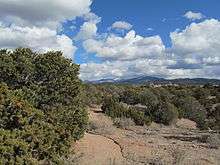Pinyon-juniper woodland
Pinyon-juniper woodland, also spelled Piñon-juniper woodland, is a vegetation type (biome) of Western United States higher elevation deserts, characterized by being an open forest dominated by low, bushy, evergreen junipers (Juniperus osteosperma,[1][2] Juniperus californica,[2][3] Juniperus grandis[3]), pinyon pines (Pinus monophylla,[2][3] Pinus edulis[2]), and their associates which vary from region to region.[1][4][5] The woodland's crown height may vary from less than 10 meters up to 15 meters, depending on the site.[6] It may consist of pure stands of pinyon pine, or pure stands of juniper.[3]
Range

The Pinyon-juniper woodland range spans from New Mexico, to the eastern Sierra Nevada, the Colorado Plateau, the Great Basin, and higher elevations of Mountain ranges of the Mojave Desert. [7] The woodland's range includes the Mogollon Rim in the south, to its northern extent in the Snake River Plain.[8]
Arizona and New Mexico
The Pinyon-juniper woodland is one of the most prevalent types of coniferous woodland in northern Arizona and New Mexico.[9]
Utah and Canyonlands Region
The pinyon-juniper plant community covers a large portion of Utah and the Canyonlands region.[1] singleleaf ash (Fraxinus anomala), and Utah serviceberry (Amelanchier utahensis) are codominants of pinyon pine and Utah juniper in this region.[1] in this region, the community occurs on rocky soils or jointed bedrock.[1]
Mojave Desert
In the steppes adjoining the Mojave Desert, this vegetation type can be found in areas receiving 12-20 inches of annual precipitation, and between 4,500 and 8,000 feet.[2] Associates include bitterbrush (Purshia glandulosa), Apache plume(Fallugia paradoxa), desert sagebrush (Artemisia tridentata), green ephedra (Ephedra viridis), mountain mahoganies (Cercocarpus spp.), and buckwheats (Eriogonum spp.).[2] In the Mojave, pinyon-juniper woodlands are generally above the Joshua Tree Woodlands vegetation type, and requires more annual precipitation.[2][10]
Sierra Nevada
In the eastern Sierra Nevada, the elevation range is 4,000-5,500 feet in the north, and 5,000 to 8,000 feet in the southern reaches of the range.[3] Pinyon-juniper woodland requires 12-20 inches of annual precipitation, so is generally located above the sagebrush scrub vegetation type, which can survive on an average of 7 inches per year.[3] It is located below the alpine zone.[3] There is often an understory dominated by sagebrush (Artemisia tridentata) and its associates.[3] Co-dominants include Jeffrey Pine (Pinus jeffreyi) and an understory of sagebrush scrub or rabbitbrush scrub (Ericameria spp.).[3]
- Junipers, dominant species:
- Pinyon Pine, dominant species:
- Pinus edulis (Colorado Pinyon or Two-needle Pinyon)
- Pinus monophylla (Single-leaf Pinyon)
See also
- Category:Flora of the Southwestern United States
- Category:Flora of the Great Basin
- Category:Flora of the California desert regions
References
- 1 2 3 4 5 Damian Fagan, Canyon Country Wildflowers, p. 3
- 1 2 3 4 5 6 7 Pam MacKay, Mojave Desert Wildflowers, p19-20
- 1 2 3 4 5 6 7 8 9 Karen Wiese, Sierra Nevada Wildflowers, 2013, p. 18
- ↑ Ronald J. Taylor, Sagebrush Country
- ↑ Laird Blackwell, Great Basin Wildflowers, p5-6
- ↑ "[Pinyon-juniper ecosystem]". Digital-Desert: Mojave Desert. Retrieved 1 February 2016.
- ↑ "Pinyon-Juniper Woodlands - Introduction & Distribution (U.S. National Park Service)". www.nps.gov. Retrieved 2018-01-26.
- ↑ Cronquist, (1972).
- ↑ Dick-Peddie, (1999) pp. 87.
- ↑ Adrienne Knute, Plants of the East Mojave, p31.
Sources
- Dick-Peddie, William A. (1999). New Mexico Vegetation: Past, Present, and Future. University of New Mexico Press. p. 280. ISBN 0-8263-2164-X.
- Cronquist, Arthur; Arthur H. Holmgren; Noel H. Holmgren; James L. Reveal; James Reveal; Noel Holmgren (1972). Intermountain Flora - Vascular Plants of the Intermountain West, U.S.A. - Geological and Botanical History of the Region, its Plant Geography and a Glossary. Vol. 1. The New York Botanical Garden Press. p. 270. ISBN 0-89327-300-7.
